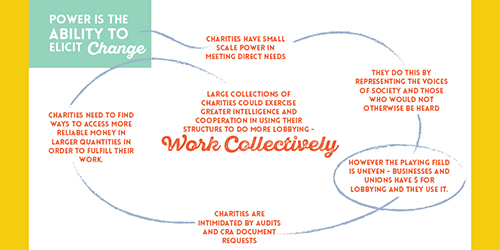Though seldom sensational, Canada's charitable activities are essential to our civil society. Our charities provide meaning, purpose, and belonging amid the dark labyrinths of alienation that characterize our time. Researching, thinking, talking, building, and envisioning in this space is no esoteric investment, a quaint concession or a salve for the guilt of our overextension and collective greed. In this paper, we explore the deep renewal we need in our conceptions of the charitable sector—how we fund, empower, and even define our charities.

(click image for full infographic)
Download PDF now: Charity and Social Capacity
YOUR TURN:
In 2016 we asked charity experts across the land this question. Now it's your turn.
If you could have a measure right now, some data or intel on charities across the country, what would that measure be?
- Measure public trust in a wide range of organizations.
- Measure volunteers more accurately and fully.
- Trust measurement is critical.
- Service areas of a given organization would be very valuable to see/know.
- The degree to which goals and objectives were attained.
- Full disclosure about the percent of government funding received.
- Make visible the invisible services, goods, benefits that are provided—for example, thinking, ideas.
- Outputs such as the number of people served and/or engaged.
- Much greater clarity about organizational distinction—type, mission, and so on.
- Measure impact—what happened as a result of what you did?
- Degree of trust from members/recipients/volunteers.
- Formation—how engaged, changed, influenced, as a result of charities' work.
- The value that society derives from the existence and function of charity.
- The degree to which the charity was a catalyst for perceptible, sustainable, flourishing for individuals and their communities.
- Reach and goal attaining vs. operation costs.
- A simple measure is not possible. An understanding how they work and what they actually do is hard to come by.
- What social problem they are trying to address.
- Percentage of annual operating budget broken down by corporate donors, private,individuals , fundraising and by various levels of government.
- What percentage of their donors give to them without being targeted with fundraising?
- (1) Volunteer Motivations by class (age, gender, income, occupation, education, religious affiliation and adherence, urban-suburban-rural location, political views, degree of alienation, etc. (2) Percent of expenses going to overhead, with clear and explicit definitions of what is allocated to overhead and what to program.
- How much does the charity seek to work/collaborate with other NGOs in the same area? How much do they spend on overhead? Do they increase dependency?
- Impact.
- What is the rate of consolidation (merges and acquisitions) among charities in Canada? What is the result of this rate on giving and ultimately impact?
- The gap between millennial giving and that of older generations.
WHY DO WE STUDY CHARITY?
Charitable work significantly underwrites many valuable aspects of our common life. The charitable sector is a critical part of life in Canada. In the year 2000 Canadians contributed $4.5 billion and gave over 1 billion hours of volunteer time to organizations they believed in. Through tax credits and other methods, governments have historically nurtured these activities—the heart of Canada’s charitable "third sector."
Economic recessions hit charities harder than most. Not only do many organizations experience a decline in giving, but often demands for the services many groups provide increases dramatically. Something needs to be done. To complicate things further, the portion of the population responsible for the bulk of volunteerism and financial giving is in decline. What will happen to these public-good services and support programs if nothing is done?
We are currently exploring how and when people in Canada donate, particularly the planned aspects of giving across the country. This will help us form a more complete picture of the donations dynamics in the Canadian charitable sector.
A useful overview of charity and the civic core was presented by President Michael Van Pelt's 2008 remarks on"Renewing Canada's Social Architecture."
This piece was originally published here.
CONTACT
Milton Friesen
Program Director, Social Cities
mfriesen@cardus.ca





